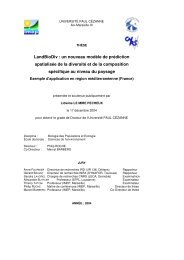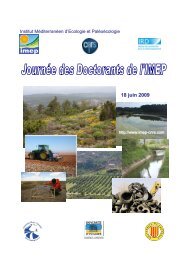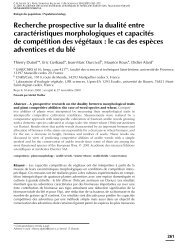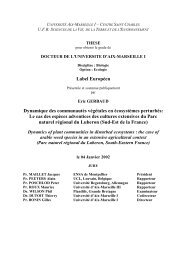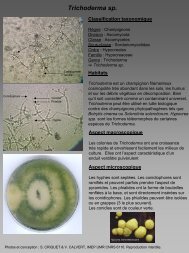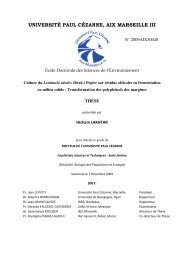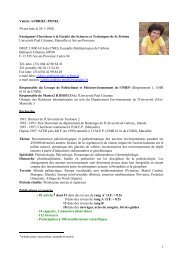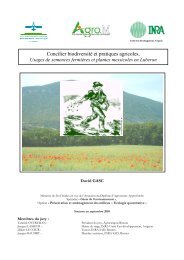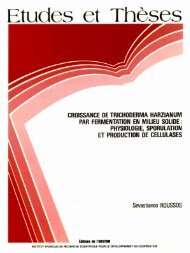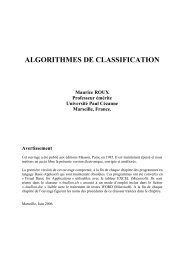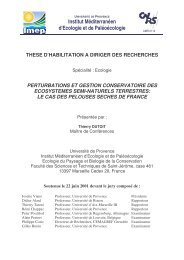Vegetation dynamics during the early to mid-Holocene ... - IMEP
Vegetation dynamics during the early to mid-Holocene ... - IMEP
Vegetation dynamics during the early to mid-Holocene ... - IMEP
You also want an ePaper? Increase the reach of your titles
YUMPU automatically turns print PDFs into web optimized ePapers that Google loves.
Veget Hist ArchaeobotDOI 10.1007/s00334-012-0380-0ORIGINAL ARTICLE<strong>Vegetation</strong> <strong>dynamics</strong> <strong>during</strong> <strong>the</strong> <strong>early</strong> <strong>to</strong> <strong>mid</strong>-<strong>Holocene</strong> transitionin NW Malta, human impact versus climatic forcingMorteza Djamali • Belinda Gambin • Nick Marriner • Valérie Andrieu-Ponel •Timmy Gambin • Emmanuel Gandouin • Sandro Lanfranco • Frédéric Médail •Daniel Pavon • Philippe Ponel • Chris<strong>to</strong>phe MorhangeReceived: 11 May 2012 / Accepted: 10 Oc<strong>to</strong>ber 2012Ó Springer-Verlag Berlin Heidelberg 2012Abstract A pollen diagram was constructed for <strong>the</strong> <strong>early</strong><strong>to</strong><strong>mid</strong>-<strong>Holocene</strong> transition (ca. 7350–5600 cal. B.P./5400–3650 B.C.) from <strong>the</strong> Burmarrad ria located in NW Malta. Thevegetation at ca. 7350–6960 cal. B.P./5400–5010 B.C. wascharacterized by an almost tree-less steppe-like open landscape.Early <strong>Holocene</strong> dry climatic conditions were mostprobably due <strong>to</strong> intensification of <strong>the</strong> subtropical monsooncirculation that streng<strong>the</strong>ned <strong>the</strong> subtropical anticyclonicdescent over <strong>the</strong> central Mediterranean and blocked <strong>the</strong>penetration of hu<strong>mid</strong> air masses from <strong>the</strong> North AtlanticOcean. At ca. 6950 cal. B.P./5000 B.C., <strong>the</strong> steppe-like vegetationwas suddenly replaced by a Mediterranean evergreenforest or dense scrub dominated by Pistacia cf. lentiscustrees. This event, which has simultaneously been recorded insou<strong>the</strong>rn Sicily, was most probably caused by <strong>the</strong> southwardshift of <strong>the</strong> ITCZ permitting <strong>the</strong> eastward movement of <strong>the</strong>North Atlantic cyclonic systems. Traces of human activitiesCommunicated by J.-L. de Beaulieu.M. Djamali (&) B. Gambin V. Andrieu-Ponel E. Gandouin F. Médail D. Pavon P. PonelIMBE–UMR CNRS 7263/IRD/Aix-Marseille Université 237,Europôle Méditerranéen de l’Arbois, BP 80,13545 Aix-en-Provence Cedex 04, Francee-mail: morteza.djamali@imbe.frN. Marriner C. MorhangeCEREGE–UMR 7330 Aix-Marseille Université, CNRS–InstitutPYTHEAS, Europôle Méditerranéen de l’Arbois, BP 80,13545 Aix-en-Provence Cedex 04, FranceT. GambinDepartment of Classics and Archaeology, University of Malta,Msida 2080, MaltaS. LanfrancoDepartment of Biology, University of Malta, Msida 2080, Maltaare evident in <strong>the</strong> pollen diagram since <strong>the</strong> beginning of <strong>the</strong>record but become more pronounced from <strong>the</strong> onset of <strong>the</strong>Temple Cultural Phase at ca. 6050 cal. B.P./4100 B.C. withagradual decline of tree pollen. We suggest that <strong>the</strong> <strong>early</strong>- <strong>to</strong><strong>mid</strong>-<strong>Holocene</strong> vegetation transformation was mainly controlledby a regional climatic change that occurred in alandscape only slightly impacted by human activities.Keywords Pollen analysis Monsoon intensification Neolithic Temple cultural phase Mediterranean Evergreen PistaciaIntroductionRecent palaeoenvironmental reconstructions from <strong>the</strong> centralMediterranean attest <strong>to</strong> contrasting patterns of hydrologicalevolution <strong>during</strong> <strong>the</strong> <strong>early</strong>- <strong>to</strong> <strong>mid</strong>-<strong>Holocene</strong>. Spatially, <strong>the</strong>seare characterized by marked west versus east and north- versussouth-central Mediterranean disparities (Magny et al. 2011,2012; Roberts et al. 2011; Vannière et al. 2011). The maindividing lines broadly run through <strong>the</strong> Balkans, sou<strong>the</strong>rn Italyand Tunisia, approximately correlating with 40°N (Magnyet al. 2011; Roberts et al. 2011). These contrasting spatialpatterns of <strong>Holocene</strong> hydrology have been attributed <strong>to</strong> differencesin seasonal precipitation (Magny et al. 2012). Discrepanciesin palaeo-records are, for instance, attestedbetween vegetation and lake-level records of <strong>the</strong> Italian Peninsula(Drescher-Schneider et al. 2007; Magny et al. 2007;Sadori et al. 2011) and those of sou<strong>the</strong>rn Sicily (Sadori andNarcisi 2001;Notietal.2009;Tinneretal.2009). However,with <strong>the</strong> exception of Sicily, <strong>the</strong> number of multi-proxy palaeoenvironmentalinvestigations, especially in <strong>the</strong> sou<strong>the</strong>rnMediterranean including Malta and North Africa, are limited<strong>to</strong> a just few records (e.g. Ben Tiba and Reille 1982; Stambouli-Essassiet al. 2007; Fenech2007), many of which lack123
Veget Hist Archaeobotchange in eastern Malta <strong>during</strong> <strong>the</strong> late-Pleis<strong>to</strong>cene <strong>to</strong> late<strong>Holocene</strong>. However, poor pollen preservation, chronologicalinversions and rapidly varying sedimentation rates, especiallyin <strong>the</strong> <strong>early</strong>- <strong>to</strong> <strong>mid</strong>-<strong>Holocene</strong>, make <strong>the</strong> interpretation of thisdiagram a difficult task (Fenech 2007).In this study, a pollen record is presented from northwesternMalta (Fig. 1) for <strong>the</strong> <strong>early</strong>- <strong>to</strong> <strong>mid</strong>-<strong>Holocene</strong>transition (ca 7350–5570 cal. B.P.). This time interval corresponds<strong>to</strong> a significant climatic change and cultural phasein <strong>the</strong> south-central Mediterranean region (e.g. Noti et al.2009; Tinner et al. 2009). Our main objectives are:Fig. 1 Shaded relief map of <strong>the</strong> Maltese Islands with <strong>the</strong> location of<strong>the</strong> studied core BM1. SKB Skorba temple site, Prl Preola, GB GorgoBasso, BdG Biviere di Gela, P Lago di Pergusarobust chronological frameworks (Sadori et al. 2011) or givefragmentary records of past climate and vegetation change(Hunt et al. 2011; Mercuri et al. 2011). The Maltese Islands(Fig. 1) are located in a key climatic position <strong>to</strong> evaluate <strong>the</strong>palaeohydrological evolution of <strong>the</strong> central Mediterraneanregion because <strong>the</strong>y lie on <strong>the</strong> presumed hydrological hingeline (e.g. Roberts et al. 2011).The Maltese islands have had a complex Quaternary faunalhis<strong>to</strong>ry characterized by <strong>the</strong> presence of extinct species ofdwarf hippopotamus and pygmy elephants (Hunt andSchembri 1997). During <strong>the</strong> Pleis<strong>to</strong>cene, <strong>the</strong> vegetation andflora of <strong>the</strong>se islands were markedly different from <strong>to</strong>day (e.g.Hunt 1997). Occurrences of presumed relict populations of <strong>the</strong>conifer Tetraclinis articulata provide an example of a oncedifferent flora, which has altered due <strong>to</strong> both climatic changesand anthropogenic activities (Haslam et al. 1977). On <strong>the</strong> o<strong>the</strong>rhand, Maltese ecosystems have been exploited by humansocieties since <strong>the</strong> sixth millennium B.C. when <strong>the</strong> islands wereoccupied by <strong>the</strong> first Neolithic communities (e.g. Malone et al.2009). The extent <strong>to</strong> which Maltese ecosystems were impactedby man <strong>during</strong> Neolithic times (Table 1) is, however,equivocal (Fenech 2007, pp. 104–105).Our knowledge of <strong>the</strong> vegetation and floral his<strong>to</strong>ry of <strong>the</strong>Maltese Islands is however very scant due <strong>to</strong> <strong>the</strong> lack of lakeand peat bogs and <strong>the</strong> rarity of o<strong>the</strong>r suitable palaeoecologicalarchives. A detailed description of <strong>the</strong> Quaternary deposits of<strong>the</strong> Maltese Islands and <strong>the</strong>ir palaeoenvironmental potentialhas been summarized in Hunt (1997) and Hunt and Schembri(1997). The available palaeovegetation works are limited <strong>to</strong>pollen analysis of a tufa deposit of unknown Pleis<strong>to</strong>cene age(Hunt 1997), a few archaeobotanical reports (e.g. Metcalfe1966) and a pollen record from Marsa in eastern Malta (see <strong>the</strong>pollen data of F. Carrol and C. Hunt presented in Fenech2007). The latter diagram gives a general image of vegetation(1) To reconstruct <strong>the</strong> vegetation <strong>dynamics</strong> <strong>during</strong> <strong>the</strong><strong>early</strong> <strong>to</strong> <strong>mid</strong>-<strong>Holocene</strong> transition in NW Maltacompared with o<strong>the</strong>r regional pollen records, particularlythose from Sicily.(2) To attempt <strong>to</strong> disentangle <strong>the</strong> human versus climaticforcings in shaping landscape and vegetation <strong>during</strong>this transition.In <strong>the</strong> absence of permanent wetland systems such as lakesand peat bogs, we have used a fine-grained ria sequence fromnorthwestern Malta (Burmarrad). We demonstrate <strong>the</strong> highpotential of <strong>the</strong>se sequences for palaeoenvironmental reconstructionin semi-arid coastal environments.SettingClimateMeteorological data from Valletta (35°54 0 N, 14°31 0 E; 70 ma.s.l.) provide a representative picture of <strong>the</strong> general climatic/bioclimaticcontext of <strong>the</strong> Maltese Islands (Fig. 2;inset). Mean annual precipitation (P) is about 519 mmmainly falling from Oc<strong>to</strong>ber <strong>to</strong> April, and mean annualtemperature (T) is 19 °C. The degree of continentality (Ic) islow (13.8 °C) with high mean temperatures for both <strong>the</strong>hottest (26.1 °C) and coldest (12.3 °C) months of <strong>the</strong> year.The average minimum absolute temperature for <strong>the</strong> coldestmonth is also high (5 °C), indicating <strong>the</strong> near absence offrosts on <strong>the</strong> islands. Malta has a Mediterranean Pluviseasonal-Oceanicbioclimate in <strong>the</strong> Global Bioclimatic ClassificationSystem, which is <strong>the</strong> most prevalent bioclimate in <strong>the</strong>Mediterranean Basin (Rivas-Martínez et al. 1999, 2004a).This bioclimate is characterized by low continentality(B21 °C), relatively high precipitation <strong>during</strong> <strong>the</strong> growingseason, and 3–10 dry months in which P B 2T. Malta displays<strong>the</strong> same bioclimatic features as sou<strong>the</strong>rn Sicily (seebioclimatic maps in Rivas-Martínez et al. 2004a, b).<strong>Vegetation</strong>The Maltese Islands fall within <strong>the</strong> Thermo-Mediterraneanvegetation belt (Haslam et al. 1977; Fig. 1.4 in Quézel and123
Veget Hist ArchaeobotTable 1 Major prehis<strong>to</strong>ric cultural phases in <strong>the</strong> Maltese Islands with ages (B.C.) attributed by different authors and a summary description ofmain cultural eventsFig. 2 Map showing <strong>the</strong> distribution of five major vegetation types andland-use units of <strong>the</strong> Maltese Islands. The inset picture represents <strong>the</strong> climatediagram of Valetta based on data derived from <strong>the</strong> website of WorldBioclimatic Classification System at: http://www.globalbioclimatics.orgMédail 2003; Rivas-Martínez et al. 2004b). This belt ischaracterized by mean temperature minima for <strong>the</strong> coldestmonth (m) of more than 3 °C and a tree vegetation generallydominated by Olea europaea, Cera<strong>to</strong>nia siliqua and Pistacialentiscus. Pinus halepensis, sclerophyllous oaks, sometimesaccompanied by deciduous oaks, may also be present(Quézel and Médail 2003). Detailed descriptions of <strong>the</strong>vegetation and flora of <strong>the</strong> Maltese Islands are found inHaslam et al. (1977) and Lanfranco (1995) among o<strong>the</strong>rs. Amore simplified picture of <strong>the</strong> vegetation is, however, givenby Schembri (1997) who divides <strong>the</strong> Maltese vegetation in<strong>to</strong>woodlands, maquis, garrigues, steppes and several smallvegetation communities. It has been suggested that woodlandswere severely impacted by human activities over manymillennia (Haslam et al. 1977; Grech 2001). The woodlandremnants are nowadays restricted <strong>to</strong> a few localities, particularlysome small stands dominated by Quercus ilex.Thislatter tree is supposed by many botanists <strong>to</strong> be <strong>the</strong> potentialforest vegetation of <strong>the</strong> Maltese Islands. Maquis are <strong>the</strong>impoverished scrub communities mainly formed after <strong>the</strong>degradation of <strong>the</strong> woodlands due <strong>to</strong> forest cutting, overgrazingand soil erosion. The semi-natural maquis dominatedby Cera<strong>to</strong>nia siliqua, Olea europaea, Pistacialentiscus and several o<strong>the</strong>r small trees/shrubs have survivedin naturally protected and inaccessible habitats such as <strong>the</strong>Globigerina valley sides. Garrigues constitute <strong>the</strong> mostcharacteristic vegetation type of <strong>the</strong> Maltese Islands predominatelyhaving developed on <strong>the</strong> karstic limes<strong>to</strong>neplateaux of inland areas. They are open communities dominatedby dwarf shrubs such as Erica multiflora, Teucriumfructicans, Thymbra capitata, and <strong>the</strong> endemic Euphorbiamelitensis and Anthyllis hermanniae ssp. melitensis,accompanied by a number of annuals and perennials. Garriguesmay occur naturally but most often form in disturbedforest and maquis with intensive soil erosion. O<strong>the</strong>r vegetationcommunities, covering much smaller terri<strong>to</strong>ries,include coastal communities, rupicolous communities rich inendemics, freshwater communities and ruderal communitiesassociated with arable and waste lands. On <strong>the</strong> MalteseIslands, <strong>the</strong> flora and vegetation have long been impacted byhuman activities, at least since <strong>the</strong> beginning of <strong>the</strong> fifthmillennium B.C. (Haslam et al. 1977). Indeed, about 40 % of<strong>the</strong> Maltese flora is composed of weeds of cultivated landsand wastelands and <strong>the</strong>re are commonly no sharp boundariesbetween <strong>the</strong> species of disturbed and undisturbed areas. Thenatural or semi-natural vegetation can only be found in smallstands restricted <strong>to</strong> some sheltered habitats such as on <strong>the</strong>Globigerina valley sides. Many of <strong>the</strong> native Maltese treesand shrubs still occur in <strong>the</strong>se sheltered habitats includingCrataegus spp., Cera<strong>to</strong>nia siliqua, Pistacia lentiscus,123
Veget Hist ArchaeobotTable 2 Radiocarbon ages for six samples from <strong>the</strong> core BM1, NW MaltaSamplenumberLab codeDepth(cm)14 C age(year B.P.)Calibr. age(cal. year B.P.)Cal. age range/probability ()MaterialdatedBM1/64A SacA-11663 845 4563 ± 30 5120 ± 655292 ± 285055–5186 (0.52)5264–5321 (0.43)CharcoalBM1/80 Poz-42441 1005 5410 ± 40 6236 ± 60 6176–6296 (0.89) CharcoalBM1/93 SacA-11668 1117.5 6115 ± 30 6964 ± 676897–7031 (0.72) Peat7125 ± 307095–7156 (0.21)BM1/100 SacA-11669 1215 6500 ± 30 7441 ± 307362 ± 377411–7472 (0.62)7325–7399 (0.38)CharcoalBM1/121 Poz-42439 1415 6650 ± 60 7521 ± 88 7433–7609 (1) CharcoalCalibrated dates are reported as means of <strong>the</strong> 2r-ranges with highest probability. Possible age-ranges with highest probabilities (in paren<strong>the</strong>ses) arealso reported as a separate column (2r-ranges). 14 C ages were calibrated by CALIB 6.1.1 based on IntCal09 calibration dataset (Reimer et al. 2009)Quercus ilex, Rhamnus lycioides ssp. oleoides and Tetraclinisarticulata, <strong>the</strong> latter being a presumed relict species(Haslam et al. 1977).Materials and methodsCoring, chronology, and stratigraphyFour cores (BM1–BM4) were recovered from <strong>the</strong> Burmarradfloodplain (NW Malta) using a percussion corer (Berettadrilling machine) in spring 2008 and 2010 (Fig. 1). The sitewas selected based on preliminary explora<strong>to</strong>ry drillingsconducted <strong>during</strong> an earlier project (Gambin 2005) thatrevealed <strong>the</strong> presence of a relatively thick and continuousterrestrial-marine sediment infill. After stratigraphicaldescriptions, core BM1 (14 m long) was subsampled every5–10 cm for fur<strong>the</strong>r pollen and sedimen<strong>to</strong>logical analyses.Five radiocarbon ages were obtained <strong>to</strong> construct <strong>the</strong> agedepthmodel. 14 C ages, reported in Table 2, were calibratedin Calib 6.1.1 using IntCal09 (Reimer et al. 2009). The agedepthmodel (Fig. 3) was constructed using non-Bayesianmodeling in <strong>the</strong> R-based package of CLAM (Blaauw 2010).The age-depth model shows an age-range of 8465–7763 cal.B.P. for <strong>the</strong> base of <strong>the</strong> core at 1,400 cm. However, in thisstudy, only <strong>the</strong> calibrated chronology for <strong>the</strong> interval of12–9 m has been shown (see below). This interval starts withupper estuarine dark grey silts (1,200–1,115 cm) whichsuddenly change in<strong>to</strong> a fine-grained peat formed in a closedfreshwater wetland system. At about 1,105 cm, lower estuarinegrey silts replace <strong>the</strong> wetland organic deposits andcontinue up <strong>to</strong> about 975 cm where <strong>the</strong>y grade in<strong>to</strong> <strong>the</strong> openmarine grey shelly sands.Pollen analysisA series of tests was conducted all along <strong>the</strong> core <strong>to</strong>locate <strong>the</strong> polliniferous sections of <strong>the</strong> sample. Thesection 1,200–900 cm presented good pollen preservationand was pollen-rich. We focused our attention on thissection with a sampling resolution of 10 cm. Extraction ofpollen grains and Non-Pollen Palynomorphs (NPPs) wasundertaken using 10 % HCl, 40 % HF, 37 % HCl andace<strong>to</strong>lysis (e.g. Moore et al. 1991). Pollen identificationwas performed with <strong>the</strong> help of <strong>the</strong> IMBE’s pollen referencecollection and <strong>the</strong> pollen atlases of Europe and NorthAfrica (Reille 1992, 1995, 1998). The Ostrya-type pollencurve may represent both Carpinus orientalis (Beug 2004)and Ostrya and <strong>the</strong> Quercus pollen curve is <strong>the</strong> sum ofQ. ilex-type and Q. pubescens-type. Dinoflagellates weredetermined by Laurent Londeix (EPOC, University ofBordeaux); NPPs were identified using Cugny (2011),Mudie et al. (2011) and Haas (1996). Pollen percentageswere calculated in TILIA and <strong>the</strong> pollen percentage diagram(Fig. 3) was constructed using TGView software(Grimm 2004–2005). In calculating pollen percentages ofupland plants i.e. trees, shrubs and herbaceous speciesgrowing on well-drained soils, aquatic and hygrophilousplants (Cyperaceae, spores, Typha/Sparganium-types) wereexcluded from <strong>the</strong> pollen sum. However, in calculating <strong>the</strong>pollen percentages of <strong>the</strong>se latter plants, <strong>the</strong>y were includedin <strong>the</strong> Total Pollen Sum. Hence, <strong>the</strong> final pollen diagram is asyn<strong>the</strong>tic diagram in which <strong>the</strong> pollen curves calculated withtwo above methods are placed <strong>to</strong>ge<strong>the</strong>r. The pollen diagramwas subdivided in<strong>to</strong> Local Pollen Assemblage Zones(LPAZs) by applying stratigraphically-constrained clusteranalysis <strong>to</strong> percentage data using CONISS software includedin <strong>the</strong> TILIA package (Grimm 1987, 2004–2005). Pollenconcentration values were also calculated by <strong>the</strong> addition ofLycopodium tablets (S<strong>to</strong>ckmarr 1971) <strong>to</strong> check that <strong>the</strong>pollen percentage variations were not an artifact of lowpollen concentration values. PCA analysis was applied <strong>to</strong>pollen percentages using XLSTAT v. 2009.3.02 (Addinsoft,Paris 1995–2009) and <strong>the</strong> axis 1 (18 % of variability) scoresfor different samples were plotted against <strong>the</strong> depth in <strong>the</strong>pollen diagram (Fig. 3).123
Veget Hist ArchaeobotChirono<strong>mid</strong> contentOnly <strong>the</strong> peaty layers yielded chirono<strong>mid</strong> capsules. Thenumber of capsules was very low (n = 9), below <strong>the</strong> statisticallysignificant level for quantitative reconstructions(n = 50; Heiri and Lotter 2001). However, as <strong>the</strong> identifiedtaxa provide significant environmental information, <strong>the</strong>yare reported and discussed in this paper. The observedchirono<strong>mid</strong> capsules were identified as belonging <strong>to</strong> <strong>the</strong>following taxa: five specimens of Paratendipes albimanustype,one specimen of Microtendipes pedellus-type, onespecimen of Polypedilum and two specimens of <strong>the</strong> groupParametriocnemus/Paraphaenocladius.DiscussionEarly- <strong>to</strong> <strong>mid</strong>-<strong>Holocene</strong> upland vegetation <strong>dynamics</strong>in NW Malta in relation <strong>to</strong> regional climate changeThe vegetation of NW Malta at ca. 7350–6960 cal. B.P./5400–5010 B.C. was characterized by an almost treelesslandscape. Very low pollen percentages of Pistacia, Erica andQuercus (both Q. ilex-type and Q. pubescens-type) suggestthat <strong>the</strong>se trees were present as small stands on <strong>the</strong> island.Open steppe-like vegetation has also been reported for <strong>the</strong><strong>early</strong> <strong>Holocene</strong>, at least for a millennial-scale interval of timebefore ca. 7000 cal. B.P., of coastal Sicily and SE Spain (Calòet al. 2012; Notietal.2009; Pantaléon-Cano et al. 2003;Tinner et al. 2009). The vegetation record at Lago di Pergusa,inland Sicily, located at higher elevations (674 m a.s.l.) andwith a wetter and cooler climate than that of <strong>the</strong> coastal zone(Calò et al. 2012), shows n<strong>early</strong> continuous re-afforestationsince <strong>the</strong> beginning of <strong>the</strong> <strong>Holocene</strong>, however with forestdevelopment having been slower than expected (Sadori et al.2008). Almost all <strong>the</strong> microscopic charcoal records of Sicilyshow higher than average fire activity <strong>during</strong> 8500–7500 cal.B.P. (Vannière et al. 2011). This is particularly prominent inGorgo Basso (Tinner et al. 2009), Lago di Pergusa (Sadoriet al. 2008) and Lago Preola (Calò et al. 2012) and suggestmore intense summer dry conditions. At ca. 6960 cal. B.P., aMediterranean evergreen forest, or dense scrub, startedexpanding, at least in <strong>the</strong> study area. Simultaneously, fireactivity displays a decreasing trend in Sicilian records (Calòet al. 2012; Sadori et al. 2008; Tinneretal.2009). This vegetationcommunity was predominately Pistacia trees but alsocontained Erica and evergreen oak (Q. ilex-type). The sporadicand low-percentage occurrences of Olea and Fraxinuspollen may be partly explained by small stands on <strong>the</strong> islandbut also by long-distant transportation from neighboring landssuch as Sicily. It should be noted that archaeobotanical findsfrom <strong>the</strong> Ghar Dalam cultural phase (ca. 6950–6250 cal. B.P./5000–4300 B.C.; see Table 1) demonstrate that deciduoustrees including Fraxinus, Cercis siliquastrum and Crataeguswere also present on <strong>the</strong> island (Metcalfe 1966) <strong>during</strong><strong>the</strong>forest expansion phase (Fig. 3; LPAZ BM1-B2). This suggeststhat <strong>the</strong> forest composition on Malta had a more diversifiedfloristic composition than is reflected by <strong>the</strong>se pollenspectra. However, <strong>the</strong> forest composition was certainly lessdiverse than <strong>the</strong> Sicilian forests judging from <strong>the</strong> more diversetree pollen assemblages in Sicilian pollen records (Calò et al.2012;Notietal.2009; Sadori and Narcisi 2001; Tinner et al.2009). This low diversity is most probably related <strong>to</strong> <strong>the</strong>smaller size and lower altitudinal variation of Malta compared<strong>to</strong> Sicily that created fewer differentiated ecological niches.Comparison of <strong>the</strong> BM1 pollen record with <strong>the</strong> Gorgo Bassodiagram in southwestern Sicily (Tinner et al. 2009) showsaremarkable chronological correlation between <strong>the</strong> abruptexpansions of Pistacia woodlands/scrub on <strong>the</strong> two islands(Fig. 4). In Lago Preola, located a few kilometres <strong>to</strong> <strong>the</strong> NW ofGorgo Basso, Pistacia expansion is recorded at ca. 7300 cal.B.P. (Calòet al. 2012). Fur<strong>the</strong>r east, at Bieviere di Gela, alsolocated in a coastal area of sou<strong>the</strong>rn Sicily, <strong>the</strong> Pistaciaexpansion occurred some 200 years later at ca. 6700 cal. B.P.(Notietal.2009). The increase of Pistacia pollen at <strong>the</strong> inlandsite of <strong>the</strong> Lago di Pergusa was also contemporaneous withthose in coastal Sicily (Fig. 6 in Sadori and Narsici Sadori andNarcisi 2001). It is known that Pistacia is under-represented inmodern pollen assemblages (e.g. Wright et al. 1967;vanZeistand Bottema 1977). In <strong>the</strong> Zagros Mountains of western Iran,<strong>the</strong> highest values of Pistacia pollen reach only 4.5 % evenwhere Pistacia trees form a significant tree cover (Wright et al.1967). However, in contrast <strong>to</strong> some Mediterranean speciessuch as P. lentiscus and P. terebinthus, pistachio species of Iranare deciduous and thus caution should be taken in generalizing<strong>the</strong>ir low pollen production <strong>to</strong> Mediterranean evergreen speciesof <strong>the</strong> genus. Pistacia pollen in <strong>the</strong> BM1 pollen diagram attainsvery high values up <strong>to</strong>[60 %, which is on average 15–20 %higher than those for Gorgo Basso and Biviere di Gela(Notietal.2009;Tinneretal.2009). Such high pollen valuessuggestthatdensePistacia woodlands or scrubs dominated<strong>the</strong> NW Maltese landscapes <strong>during</strong> ca. 6960–5600 cal.B.P./5010–3650 B.C. Ecological interpretation of Pistacia pollenvariations, however, depends on <strong>the</strong> pistachio species that hasproduced <strong>the</strong> pollen because different species indicate differentbioclimatic and ecological conditions (Sadori et al. 2011). In<strong>the</strong> case of Malta and Sicily, <strong>the</strong> main producer of pistachiopollen is most probably Pistacia lentiscus, a <strong>the</strong>rmophilousevergreen species that, in association with Olea europaea andCera<strong>to</strong>nia siliqua, may form a veritable forest or scrub in <strong>the</strong>Thermo-Mediterranean belt, with a diverse floristic structure(Quézel and Médail 2003). This tree is currently <strong>the</strong> mostfrequent native pistachio species in Malta, <strong>the</strong> two o<strong>the</strong>rcommon Mediterranean species not being native (P. atlantica)or extremely rare (P. terebinthus) (Weber and Kendzior2006).123
Veget Hist ArchaeobotA. fistulosus (Haslam et al. 1977; Weber and Kendzior2006). Here we use A. ramosus <strong>to</strong> encompass bothA. aestivus and A. microcarpus, following <strong>the</strong> typificationof Díaz Lifante and Valdés (1994). A. fistulosus is a rarespecies mostly found in sheltered rocky habitats and doesnot appear <strong>to</strong> be an indica<strong>to</strong>r of human activities (Haslamet al. 1977). However, A. ramosus forms large populationsin nutrient deficient soils and can show overgrazingbecause it is not eaten by grazing animals (Weber andKendzior 2006). The increase in pollen percentages of Asphodelusis associated with high values of Pistacia pollensuggesting an increase in hu<strong>mid</strong>ity that in turn caused <strong>the</strong>forest expansion. This fact is somehow contradic<strong>to</strong>ry with<strong>the</strong> ecology of Mediterranean Asphodelus which are plants ofopen environments/steppe habitats (Grove and Rackham2001). One way <strong>to</strong> explain <strong>the</strong> increasing Asphodelus pollenvalues is that <strong>the</strong> asphodel pollen was produced by A. ramosusin <strong>the</strong> slightly disturbed areas of NW Malta, whichwere <strong>the</strong>n of limited extent compared <strong>to</strong> <strong>the</strong> vast woody areasof <strong>the</strong> island especially in <strong>the</strong> more rocky habitats. A. ramosus(A. microcarpus) represents a well-known indica<strong>to</strong>r of overgrazingand man-made firing of <strong>the</strong> landscape in <strong>the</strong> semi-aridMediterranean regions (Pantis and Margaris 1988). Thesimultaneous increase of Plantago lanceolata-type and Rumexace<strong>to</strong>sa-type pollen, o<strong>the</strong>r indica<strong>to</strong>rs of disturbed areas, reinforcesthis interpretation (Fig. 3).Today, Valerianella is represented by two species inMalta, V. eriocarpa and V. muricata with <strong>the</strong> former speciesoccurring more frequently. V. eriocarpa may grow in cultivatedand waste lands (Haslam et al. 1977; Weber andKendzior 2006) suggesting that <strong>the</strong> appearance andincreasing values of Valerianella pollen since ca. 6100 cal.B.P./4150 B.C. can be interpreted with confidence as a signatureof increased disturbance of natural ecosystems byhuman activities. Variations in Theligonum pollen percentagesare more difficult <strong>to</strong> explain. Theligonum cynocrambe,<strong>the</strong> only Mediterranean species of <strong>the</strong> genus, is a commonannual on <strong>the</strong> Maltese Islands especially growing on walls,derelict fields, and in rocky or s<strong>to</strong>ny habitats (Haslam et al.1977). Increased values of Theligonum may indicate thathuman activities created more derelict agricultural areas androcky/s<strong>to</strong>ny habitats favorable for <strong>the</strong> growth of this plant. In<strong>the</strong> flora of Syria and Lebanon, Mouterde (1966) reports thatTheligonum is closely associated with road sides, rockyhabitats, and low wall structures and has a long floweringseason (January <strong>to</strong> May). In Mediterranean France andCorsica, <strong>the</strong> s<strong>to</strong>ny surfaces created by scree slope depositsand low wall structures separating terraced farmlands areintensively colonized by Theligonum. These observations,<strong>to</strong>ge<strong>the</strong>r with increasing values of cereals and o<strong>the</strong>r anthropogenicindica<strong>to</strong>rs, suggest that <strong>the</strong> Theligonum pollencurve, in Malta, may reflect <strong>the</strong> establishment and developmen<strong>to</strong>f terrace agriculture, at least in <strong>the</strong> Burmarrad ria.Local hydrological evolutionTemporal variations in <strong>the</strong> pollen of aquatic/hygrophilousplants as well as <strong>the</strong> NPPs in <strong>the</strong> BM1 diagram shed light on<strong>the</strong> local hydrological <strong>dynamics</strong> of <strong>the</strong> Burmarrad ria. ThePCA Axis 1 values cl<strong>early</strong> follow <strong>the</strong> variations of aquaticversus terrestrial plants as <strong>the</strong> most important aspect of <strong>the</strong>vegetation change in <strong>the</strong> Burmarrad ria <strong>during</strong> <strong>the</strong> timeinterval covered by <strong>the</strong> BM1 diagram (18 % of variability).At <strong>the</strong> onset of <strong>the</strong> LPAZ BM1-A1 (Figs. 3, 5), where <strong>the</strong>sediment composition suggests an upper estuarine environment,high percentages of Cyperaceae pollen followed bySparganium-type pollen (Sparganium spp. and/or Typhaangustifolia) indicate <strong>the</strong> presence of terrestrial freshwater <strong>to</strong>brackish water bodies in <strong>the</strong> Burmarrad alluvial plain, whichwere transported in<strong>to</strong> and deposited in an estuarine environmentespecially via fluvial systems. The presence ofPhaeoceros laevis spores fur<strong>the</strong>r suggests <strong>the</strong> abundance ofwet acidic soils, most probably around <strong>the</strong> lakes/ponds or on<strong>the</strong> river floodplains (e.g. Sérgio 2004). This bryophytespecies lives in shallow water. Very low values of dinoflagellatecysts and microforaminifera show <strong>the</strong> dominance ofterrestrial ra<strong>the</strong>r than marine influences. The explosion ofCyperaceae pollen in <strong>the</strong> BM1-A2 subzone shows <strong>the</strong>development of a freshwater peat bog in <strong>the</strong> area by ca.7000 cal. B.P./5050 B.C. The ecology of <strong>the</strong> identified chirono<strong>mid</strong>sfrom <strong>the</strong> peat layer interval of 1,115–1,110 cmprovides more details on <strong>the</strong> palaeoenvironment contemporaneous<strong>to</strong> this short time span:Paratendipes albimanus-type. This species is found inlowland streams and small and large rivers with <strong>the</strong>ir sidechannels but rarely in standing water (Moller Pillot andBuskens 1990). It also occurs in soft sediments in <strong>the</strong> lit<strong>to</strong>ralareas of mesotrophic lakes (Brodin 1986; Sae<strong>the</strong>r 1979).According <strong>to</strong> Rossaro (1991), Paratendipes spp. in Italianrunning waters (data set of 991 sites and 127 taxa) has anoptimum water temperature of 17.3 °C (standard deviationof 2.3 °C). In Gandouin et al. (2006) <strong>the</strong> genus is consideredas ubiqui<strong>to</strong>us in <strong>the</strong> river chirono<strong>mid</strong> typology (but <strong>to</strong>wards<strong>the</strong> lotic taxa in <strong>the</strong> connection gradient between <strong>the</strong> mainchannel and <strong>the</strong> o<strong>the</strong>r floodplain water bodies).Microtendipes pedellus-type. The genus is common inlit<strong>to</strong>ral and sublit<strong>to</strong>ral sediments of lentic waters (Pinderand Reiss 1983), often in coarse sediments with loworganic content (Hofmann 1984; Brodersen and Lindegaard1999). Brooks and Birks (2001) consider <strong>the</strong> genus asan indica<strong>to</strong>r of intermediate temperatures in nor<strong>the</strong>rnEurope. For Rossaro (1991), Microtendipes spp. have anoptimum water temperature of 9.1 °C (SD = 3.1 °C). It isa lentic genus in <strong>the</strong> typology of Gandouin et al. (2006).Polypedilum. The genus is an indica<strong>to</strong>r of temperateclimatic conditions (Brooks et al. 2007). It is found in <strong>the</strong>lit<strong>to</strong>ral (Hofmann 1984) of eutrophic lakes (Klink 2002)123
Veget Hist ArchaeobotFig. 5 Timetable comparing Local Pollen Assemblage Zones, lithological units and reconstructed vegetation types with prehis<strong>to</strong>ric culturalphases of <strong>the</strong> Maltese Islandsoften associated with <strong>the</strong> macrophytic vegetation (Buskens1987; Brodersen et al. 2001). Many species are warm waterspecies in Italian running waters (Rossaro 1991) with anoptimum water temperature of 21.4 °C for Polypedilumspp. The genus is ubiqui<strong>to</strong>us according <strong>to</strong> Gandouin et al.(2006) but <strong>to</strong>wards <strong>the</strong> lentic taxa in <strong>the</strong> gradient of connection.P. nubeculosum has been described as a euryhalinespecies by Remane (Remane and Schlieper 1958). However,Tourenq (1975), in <strong>the</strong> Camargue delta, has nevercaptured it in brackish waters but only in freshwater areas.Parametriocnemus/Paraphaenocladius. The subfossillarval head-capsules of <strong>the</strong>se two genera cannot be separated.However, Parametriocnemus and Paraphaenocladiusboth occur in streams and sometimes in <strong>the</strong> lit<strong>to</strong>ralzone of lakes (Moog 1995). Paraphaenocladius species arefound in moist <strong>to</strong> wet soils (Klink and Moller Pillot 2003).According <strong>to</strong> Rossaro (1991), Parametriocnemus is representedby only one species: P. stylatus with optimum watertemperatures of about 11.4 °C (SD = 4.1 °C). This speciesis found in springs and spring-fed upper reaches of streams(Moller Pillot and Buskens 1990).In summary, <strong>the</strong> ecology of <strong>the</strong> chirono<strong>mid</strong> assemblagefound in this interval suggests a freshwater river system withlow-energy flows under relatively temperate climateconditions. Waters seem <strong>to</strong> have been mesotrophic <strong>to</strong> eutrophic,with <strong>the</strong> presence of macrophytic vegetation and/or wetsoils or temporary ponds on <strong>the</strong> river floodplain.The <strong>mid</strong>-<strong>Holocene</strong> marine transgression caused anincrease in <strong>the</strong> salt content of <strong>the</strong> lit<strong>to</strong>ral wetlands and led <strong>to</strong><strong>the</strong> expansion of halophilous plants such as Chenopodiaceae(LPAZ BM1-B1). Increased values of halophilous Chenopodiaceaepollen in coastal fluvio-deltaic complexes are acommon feature of marine inundation phases (e.g. Gandouinet al. 2009) which result in <strong>the</strong> formation of estuarinebrackish marshes. A continued rise of sea water established atrue marine environment (lower estuarine environment) at<strong>the</strong> site of BM1 at ca. 6900 cal. B.P./4950 B.C. characterizedby increasing values of dinoflagellates and microforaminifera.These depositional conditions persisted up <strong>to</strong> <strong>the</strong> <strong>to</strong>p of<strong>the</strong> diagram. The reappearance of Phaeoceros laevis spores<strong>during</strong> <strong>the</strong> LPAZ BM1-C may be linked <strong>to</strong> human activitiesas this species is also known as ‘‘segetal’’ or farming-associated(Auguier 1966). Its spores may have been transportedin<strong>to</strong> <strong>the</strong> Burmarrad upper estuarine environment by surfacerunoff. This hypo<strong>the</strong>sis is reinforced when <strong>the</strong> variations ofsome NPPs and pollen taxa are considered (see <strong>the</strong> abovesection). In a coastal wetland in SE Spain, a Pseudoschizaea(formerly Concentricystes) increase has been attributed <strong>to</strong>123
Veget Hist Archaeobotboth warm temperatures with seasonal drying and alsoincreased input of minerogenic sediments via fluvial systems(e.g. Carrión and Navarro 2002). In <strong>the</strong> Black Sea, it has beenfound in <strong>the</strong> late <strong>Holocene</strong> layers, while in <strong>the</strong> <strong>early</strong> <strong>Holocene</strong>brackish waters of <strong>the</strong> same basin it has not been found(Mudie et al. 2011). This may suggest a link with increasedanthropogenic activities in <strong>the</strong> Black Sea drainage basin. Itsincrease in <strong>the</strong> Burmarrad palaeo-estuarine environmentmay thus be better interpreted as being related <strong>to</strong> a slightincrease in soil erosion due <strong>to</strong> human activities in accordancewith o<strong>the</strong>r anthropogenic indica<strong>to</strong>rs.ConclusionsThe main trends of vegetation change in NW Malta <strong>during</strong><strong>the</strong> <strong>early</strong> <strong>to</strong> <strong>mid</strong>-<strong>Holocene</strong> transition were similar <strong>to</strong> o<strong>the</strong>rregional vegetation records from <strong>the</strong> south-central Mediterraneanregion, especially those of coastal Sicily characterizedby <strong>the</strong> transformation of a steppe-like vegetation/garrigue in<strong>to</strong> a dense shrubland/maquis dominated byevergreen Pistacia. Differences in <strong>the</strong> vegetation <strong>dynamics</strong>seem <strong>to</strong> be mostly linked <strong>to</strong> <strong>the</strong> different phy<strong>to</strong>geographicaland floristic contexts of Malta in relation <strong>to</strong> neighboringareas. The ca. 2,000-year pollen record presented in thisstudy shows that <strong>the</strong> potential natural vegetation of <strong>the</strong>Maltese islands in <strong>the</strong> absence of human pressure is notnecessarily an evergreen oak forest dominated by Quercusilex, but can be a Mediterranean evergreen shrubland orsmall woodland comprising Pistacia cf. lentiscus and mostprobably o<strong>the</strong>r insect-pollinated trees and shrubs not representedin <strong>the</strong> pollen assemblages (e.g. Cera<strong>to</strong>nia siliqua).Malta and Sicily are located at a key climatic point in <strong>the</strong>central Mediterranean because <strong>the</strong> <strong>Holocene</strong> climatic his<strong>to</strong>ryshows different palaeohydrological patterns, <strong>to</strong> <strong>the</strong> north andsouth of <strong>the</strong>ir latitudinal position. Their different vegetationand hydrological <strong>dynamics</strong> may reflect a stronger effect of<strong>the</strong> streng<strong>the</strong>ned subtropical monsoon systems <strong>during</strong> periodsof <strong>the</strong> Nor<strong>the</strong>rn Hemisphere boreal solar insolationmaxima. Although <strong>the</strong> traces of human activities in <strong>the</strong>studied area are evident from <strong>the</strong> beginning of <strong>the</strong> diagram atca. 7350 cal. B.P./5350 B.C., human presence has becomemore evident since <strong>the</strong> beginning of <strong>the</strong> Temple culturalphase at ca. 6050 cal. B.P./4100 B.C. through a conspicuousreduction in tree pollen and increasing values of anthropogenicpollen indica<strong>to</strong>rs of overgrazing and soil erosion. Aswith coastal Sicily, we suggest that <strong>the</strong> <strong>early</strong>- <strong>to</strong> <strong>mid</strong>-<strong>Holocene</strong>vegetation transformation was mainly controlled by aregional climatic change that occurred in a landscape onlyslightly impacted by human activities.Acknowledgments This study was supported by <strong>the</strong> PALEOMEDproject (ANR 09-BLAN-0323-204 01) financed by <strong>the</strong> FrenchNational Research Agency. The first author wishes <strong>to</strong> thank LaurentLondeix, Maria Sanchez Goñi, Jean-Louis Turon, and FrédériqueEynaud from EPOC, for <strong>the</strong>ir hospitality and valuable advice ondinoflagellate identification and scientific discussions <strong>during</strong> hisresearch stay at <strong>the</strong> University of Bordeaux in January 2011. We arealso thankful <strong>to</strong> Willy Tinner for his invaluable comments on <strong>the</strong>BM1 pollen diagram and Arne Saatkamp for his assistance withbotanical interpretation of <strong>the</strong> diagram. Constructive and thoughtfulcomments of <strong>the</strong> two reviewers of this paper are greatly appreciated.ReferencesAuguier J (1966) Flore des bryophytes. Lechevalier, ParisBen Tiba B, Reille M (1982) Recherches pollenanalytiques dans lesmontagnes de Kroumirie (Tunisie septentrionale): premiersrésultats. Ecol Mediterr 8:75–86Benslama M, Andrieu-Ponel V, Guiter F, Reille M, Migliore J, deBeaulieu J-L, Djamali M (2010) Nouvelles contributions àl’his<strong>to</strong>ire tardiglaciaire et holocène de la végétation en Algérie:analyses polliniques de deux profils sédimentaires du complexehu<strong>mid</strong>e d’El-Kala. CR Biol 333:744–754Beug H-J (2004) Leitfaden der Pollenbestimmung für Mitteleuropaund angrenzende Gebiete. Pfeil, MünchenBlaauw M (2010) Methods and code for ‘classical’ age-modelling ofradiocarbon sequences. Quat Geochronol 5:512–518Blouet B (2007) The s<strong>to</strong>ry of Malta, revised edn. Allied Publications,MaltaBonanno A (2005) Malta, Phoenician, Punic and Roman. MidseaBooks Ltd., MaltaBrodersen KP, Lindegaard C (1999) Classification, assessment andtrophic reconstruction of Danish lakes using chirono<strong>mid</strong>s.Freshw Biol 42:143–157Brodersen KP, Odgaard BV, Vestergaard O, Anderson NJ (2001)Chirono<strong>mid</strong> stratigraphy in <strong>the</strong> shallow and eutrophic LakeSobygaard, Denmark: chirono<strong>mid</strong>-macrophyte co-occurrence.Freshw Biol 46:253–267Brodin YW (1986) The postglacial his<strong>to</strong>ry of Lake Flarken, sou<strong>the</strong>rnSweden; interpreted from subfossil insect remains. Internat RevGesamt Hydrobiol 71:371–432Brooks SJ, Birks HJB (2001) Chirono<strong>mid</strong>-inferred air temperaturesfrom late-glacial and <strong>Holocene</strong> sites in north-west Europe:progress and problems. Quat Sci Rev 20:1,723–1,741Brooks SJ, Langdon PG, Heiri O (2007) The identification and use ofpalaearctic chirono<strong>mid</strong>ae larvae in palaeoecology. QRA TechnicalGuide No 10. Quat Res Ass, LondonBuskens RFM (1987) The chirono<strong>mid</strong> assemblages in shallow lenticwaters differing in acidity, buffering capacity and trophic levelin <strong>the</strong> Ne<strong>the</strong>rlands. En<strong>to</strong>mol Scand Suppl 29:217–224Calò C, Henne PD, Curry B, Magny M, Vescovi E, La Mantia T,Pasta S, Vannière B, Tinner W (2012) Spatio-temporal patternsof <strong>Holocene</strong> environmental change in sou<strong>the</strong>rn Sicily. PalaeogeogrPalaeoclima<strong>to</strong>l Palaeoecol 323–325:110–122Carrión JS, Navarro C (2002) Cryp<strong>to</strong>gam spores and o<strong>the</strong>r non-pollenmicrofossils as sources of palaeoecological information: casestudiesfrom Spain. Annal Bot Fin 39:1–14Cassar C (2000) A concise his<strong>to</strong>ry of Malta, 2nd edn. MiveraPublications Ltd., MaltaCassar LF, Conrad E, Schembri PJ (2007) The Maltese Archipelago.In: Vogiatzakis IN, Pungetti GA, Manion M (eds) Mediterraneanisland landscapes. Landscape series No 9, pp 297–322Cugny C (2011) Apports des microfossiles non-polliniques à l’his<strong>to</strong>iredu pas<strong>to</strong>ralisme sur le versant nord Pyrénéen entreréférentiels actuels et reconstitution du passé. PhD <strong>the</strong>sis,Université Toulouse 2 Le Mirail123
Veget Hist ArchaeobotDíaz Lifante Z, Valdés B (1994) Lec<strong>to</strong>typification of Asphodelusramosus (Asphodelaceae), a misunders<strong>to</strong>od Linnaean name.Taxon 43:245–251Djamali M, Akhani H, Andrieu-Ponel V, Bracconnot P, Brewer S, deBeaulieu J-L, Fleitmann D, Fleury J, Gasse F, Guibal F, JacksonST, Lézine A-M, Médail M, Ponel P, Roberts N, Stevens L(2010) Indian Summer Monsoon variations could have affected<strong>the</strong> <strong>early</strong> <strong>Holocene</strong> woodland expansion in <strong>the</strong> Near East.<strong>Holocene</strong> 20:813–820Drescher-Schneider R, de Beaulieu J-L, Magny M, Walter-SimonnetAV, Bossuet G, Millet L et al (2007) <strong>Vegetation</strong> his<strong>to</strong>ry, climateand human impact over <strong>the</strong> last 15 000 years at Lago dell’Accesa(Tuscany, Central Italy). Veget Hist Archaeobot 16:279–299Emeis K-C (2007) Sapropels. In: Gornitz V (ed) Encyclopedia ofclima<strong>to</strong>logy and ancient environments. Encyclopaedia of earthsciences series, part 18, pp 876–877Fenech K (2007) Human induced changes in <strong>the</strong> environment andlandscape of <strong>the</strong> Maltese Islands from <strong>the</strong> Neolithic <strong>to</strong> <strong>the</strong> 15thcentury AD. BAR Internat Ser 1,682, OxfordFleitmann D, Burns SJ, Mangini A, Mudlesee M, Kramers J, Villa I, NeffU, Al-Subbary AA, Buettner A, Hippler D, Matter A (2007)<strong>Holocene</strong> ITCZ and Indian monsoon <strong>dynamics</strong> recorded in stalagmitesfrom Oman and Yemen (Socotra). Quat Sci Rev 26:170–188Gambin T (2005) The maritime landscapes of Malta from <strong>the</strong> Romanperiod <strong>to</strong> <strong>the</strong> Middle Ages. Unpublished PhD <strong>the</strong>sis, Universityof Bris<strong>to</strong>l, Bris<strong>to</strong>lGandouin E, Maasri A, Van Vliet-Lanoë B, Franquet E (2006)Chirono<strong>mid</strong> (Insecta: Diptera) assemblages from a gradient oflotic and lentic waterbodies in river floodplains of France: amethodological <strong>to</strong>ol for palaeoecological applications. J Paleolimnol35:149–166Gandouin E, Ponel P, Andrieu-Ponel V, Guiter F, de Beaulieu J-L,Djamali M, Franquet E, van Vliet-Lanoë B, Alvitre M, MeurisseM, Brocandel M, Brulhet J (2009) 10,000 years of vegetationhis<strong>to</strong>ry of <strong>the</strong> Aa palaeoestuary, St-Omer Basin, nor<strong>the</strong>rn France.Rev Palaeobot Palynol 156:307–318García-Fayos P, Verdú M (1998) Soil seed bank, fac<strong>to</strong>rs controllinggermination and establishment of a Mediterranean shrub:Pistacia lentiscus L. Acta Oecol 19:357–366Grech CF (2001) A forest his<strong>to</strong>ry of <strong>the</strong> Maltese islands <strong>to</strong> AD 1800.Unpublished PhD <strong>the</strong>sis, University of Aberdeen, AberdeenGrimm EC (1987) Coniss: a Fortran 77 program for stratigraphicallyconstrained cluster analysis by <strong>the</strong> method of incremental sum ofsquares. Comput Geosci 13:13–35Grimm EC (2004–2005) TILIA and TGView software, version 2.0.2.Illinois State University, Springfield, USAGrove AT, Rackham O (2001) The nature of Mediterranean Europe;an ecological his<strong>to</strong>ry. Yale University Press, LondonHaas J-N (1996) Palaeoecological indica<strong>to</strong>rs found in pollen preparationsfrom <strong>Holocene</strong> freshwater lake sediments. Rev PalaeobotPalynol 91:371–382Haslam SM, Sell PD, Wolseley PA (1977) A flora of <strong>the</strong> MalteseIslands. Malta University Press, MsidaHeiri O, Lotter AF (2001) Effect of low count sums on quantitativeenvironmental reconstruction: an example using subfossil chirono<strong>mid</strong>s.J Paleolimnol 26:343–350Hofmann W (1984) Stratigraphie subfossiler Cladocera (Crustacea)und Chirono<strong>mid</strong>ae (Diptera) in zwei Sedimentprofilen desMeerfelder Maares. Cour Forsch-Inst Senckenberg 65:67–80Hunt CO (1997) Quaternary deposits in <strong>the</strong> Maltese Islands: amicrocosm of environmental change in Mediterranean lands.Geo J 41:101–109Hunt CO, Schembri PJ (1997) Quaternary environments and biogeographyof <strong>the</strong> Maltese Islands. In: Mifsud A, Savona Ventura C(eds) Facets of Maltese prehis<strong>to</strong>ry. The Prehis<strong>to</strong>ric Society ofMalta, Malta, pp 41–75Hunt CO, Brooks I, Meneely J, Brown D, Buzaian A, Barker G (2011)The Cyrenaican Prehis<strong>to</strong>ry Project 2011: Late-<strong>Holocene</strong> environmentsand human activity from a cave fill in Cyrenaica,Libya. Libyan Stud 42:77–87Incarbona A, Di Stefano E, Patti B, Pelosi N, Bonomo S, Mazzola S,Sprovieri R, Tranchida G, Zgozi S, Bonnano A (2008) <strong>Holocene</strong>millennial-scale variations in <strong>the</strong> Sicily Channel (MediterraneanSea). Paleoceanogr 23:PA3204Jordano P (1988) Polinización y variabilidad de la producción desemillas en Pistacia lentiscus L. (Anacardiaceae). Anales delJardín Botánico de Madrid 45:213–231Jordano P (1989) Pre-dispersal biology of Pistacia lentiscus (Anacardiaceae):cumulative effects on seed removal by birds. Oikos55:375–386Klink AG (2002) Determineersleutel voor de larven van de inNederland voorkomende soorten Polypedilum. Concept uitgaveSTOWA 06Klink AG, Moller Pillot HKM (2003) Chirono<strong>mid</strong>ae larvae. Key <strong>to</strong> <strong>the</strong>higher taxa and species of <strong>the</strong> lowlands of Northwestern Europe.World Biodiversity Database CD-ROM series. Expert Center forTaxonomic Identification, University of Amsterdam, AmsterdamLanfranco E (1995) The vegetation of <strong>the</strong> Maltese Islands. In: GiustiF, Manganelli G, Schembri PJ (eds) The non-marine molluscs of<strong>the</strong> Maltese Islands. Museo Regionale di Scienze Naturali,Torino, pp 27–29Larcher W (2000) Temperature stress and survival ability ofMediterranean sclerophyllous plants. Plant Biosyst 134:279–295Magny M, Vannière B, de Beaulieu J-L, Bégeot C, Heiri O, Millet Oet al (2007) <strong>Holocene</strong> climate changes in <strong>the</strong> central Mediterraneanas recorded by lake-level fluctuations at Lake Accesa(Tuscany, Italy). Quat Sci Rev 26:1,951–1,964Magny M, Vannière B, Calo C, Millet L, Leroux A, Peyron O,Zanchetta G, La Mantia T, Tinner W (2011) <strong>Holocene</strong> hydrologicalchanges in south-western Mediterranean as recorded bylake-level fluctuations at Lago Preola, a coastal lake in sou<strong>the</strong>rnSicily, Italy. Quat Sci Rev 30:2,459–2,475Magny M, Peyron O, Sadori L, Ortu E, Zanchetta G, Vannière B,Tinner W (2012) Contrasting patterns of precipitation seasonality<strong>during</strong> <strong>the</strong> <strong>Holocene</strong> in <strong>the</strong> south- and north-central Mediterranean.J Quat Sci 27:290–296Magri D, Sadori L (1999) Late Pleis<strong>to</strong>cene and <strong>Holocene</strong> pollenstratigraphy at Lago di Vico, central Italy. Veget Hist Archaeobot8:247–260Malone C, S<strong>to</strong>ddart S, Trump D, Bonanno A, Gouder T, Pace A(2009) Mortuary cus<strong>to</strong>ms in prehis<strong>to</strong>ric Malta: Excavations at<strong>the</strong> Broch<strong>to</strong>rff Circle at Xaghra, Gozo (1987–1994). McDonaldInstitute Monographs, McDonald Institute for ArchaeologicalResearch, CambridgeMartínez-Pallé E, Aronne G (2000) Reproductive cycle of Pistacialentiscus (Anacardiaceae) in Sou<strong>the</strong>rn Italy. Plant Biosyst134:365–371Mercuri AM, Sadori L, Uzquiano Ollero P (2011) Mediterranean andnorth-African cultural adaptations <strong>to</strong> <strong>mid</strong>-<strong>Holocene</strong> environmentaland climatic changes. <strong>Holocene</strong> 21:189–206Metcalfe CR (1966) Report on <strong>the</strong> botanical determination ofcharcoal samples. In: Trump DH (ed) Skorba: excavationscarried out on behalf of <strong>the</strong> National Museum of Malta,1961–1963. Reports of <strong>the</strong> Research Committee of <strong>the</strong> Societyof Antiquaries of London, Appendix V. The Society ofAntiquaries, London and <strong>the</strong> National Museum of MaltaMoller Pillot HKM, Buskens RFM (1990) De larven des NederlandseChirono<strong>mid</strong>ae (Diptera). Deel 1C. au<strong>to</strong>ekologie en werspreiding.Nederlandse faunistische Medelingen 1CMoog O (1995) Fauna Aquatica Austriaca. Abteilung fürHydrobiologie. Fischereiwirtschaft und Aquakultur der Universitätfür Bodenkultur, Wien123
Veget Hist ArchaeobotMoore PD, Webb JA, Collinson ME (1991) Pollen analysis, 2nd edn.Blackwell, OxfordMouterde P (1966) La nouvelle flore du Liban et de la Syrie. TomePremier, Editions de l’Imprimerie Catholique, BayrouthMudie PJ, Leroy SAG, Marret F, Gerasimenko N, Kholeif SEA, SapelkoT, Filipova-Marinova M (2011) Nonpollen palynomorphs: indica<strong>to</strong>rsof salinity and environmental change in <strong>the</strong> Caspian-BlackSea-Mediterranean corridor. The Geological Society of AmericaSpecial Paper 473:1–27Noti R, Van Leeuwen JFN, Colombaroli D, Vescovi E, Pasta S, LaMantia T, Tinner W (2009) Mid- and late-<strong>Holocene</strong> vegetationand fire his<strong>to</strong>ry at Biviere di Gela, a coastal lake in sou<strong>the</strong>rnSicily, Italy. Veget Hist Archaeobot 18:371–387Palacio S, Milla R, Montserrat-Martí G (2005) A phenologicalhypo<strong>the</strong>sis on <strong>the</strong> <strong>the</strong>rmophilous distribution of Pistacia lentiscusL. Flora 200:527–534Pantaléon-Cano J, Yll E-I, Pérez-Obiol R, Roure JM (2003) Palynologicalevidence for vegetational his<strong>to</strong>ry in semi-arid areas of <strong>the</strong>western Mediterranean (Almería, Spain). <strong>Holocene</strong> 13:109–119Pantis J, Margaris NS (1988) Can systems dominated by asphodels beconsidered as semi-deserts? Int J Biomet 32:87–91Pérez-Obiol R, Jalut G, Julià R, Pèlachs A, Iriarte MJ, Ot<strong>to</strong> T,Hernández-Beloqui B (2011) Mid-<strong>Holocene</strong> vegetation andclimatic his<strong>to</strong>ry of <strong>the</strong> Iberian Peninsula. <strong>Holocene</strong> 21:75–93Pinder LCV, Reiss F (1983) The larvae of Chironominae (Diptera:Chirono<strong>mid</strong>ae) of <strong>the</strong> Holarctic region. Keys and diagnoses.En<strong>to</strong>mol Scand Suppl 19:293–435Pons A (1981) The his<strong>to</strong>ry of <strong>the</strong> mediterranean shrublands. In: DiCastri F, Goodall DW, Spetch RL (eds) Mediterranean-typeshrublands. Elsevier, Amsterdam, pp 131–138Quézel P, Médail F (2003) Ecologie et biogéographie des forêts dubassin méditerranéen. Elsevier, ParisReille M (1992) Pollen et spores d’Europe et d’Afrique du Nord.Labora<strong>to</strong>ire de botanique his<strong>to</strong>rique et de palynologie, MarseilleReille M (1995) Pollen et spores d’Europe et d’Afrique du Nord.Labora<strong>to</strong>ire de botanique his<strong>to</strong>rique et de palynologie-Suppl 1,MarseilleReille M (1998) Pollen et spores d’Europe et d’Afrique du Nord.Labora<strong>to</strong>ire de botanique his<strong>to</strong>rique et de palynologie-Suppl 2,MarseilleReimer PJ, Baillie MGL, Bard E, Bayliss A, Beck JW, Blackwell PG,Bronk Ramsey C, Buck CE, Burr GS, Edwards RL, Friedrich M,Grootes PM, Guilderson TP, Hajdas I, Hea<strong>to</strong>n TJ, Hogg AG,Hughen KA, Kaiser KF, Kromer B, McCormac FG, ManningSW, Reimer RW, Richards DA, Southon JR, Talamo S, TurneyCSM, Van der Plicht J, Weyhenmeyer CE (2009) IntCal09 andMarine09 radiocarbon age calibration curves, 0–50,000 years -cal BP. Radiocarbon 51:1,111–1,150Remane A, Schlieper C (1958) Die Biologie des Brackwassers. DieBinnengewässer, 22, StuttgartRivas-Martínez S, Sánchez-Mata D, Costa M (1999) Boreal andwestern temperate forest vegetation (syntaxonomical synopsis of<strong>the</strong> potential natural plant communities of North America II).Itinera Geobotanica 12:3–311Rivas-Martínez S, Penas A, Diaz TE (2004a) Bioclimatic map ofEurope: bioclimates. Car<strong>to</strong>graphic Service, University of León,LeónRivas-Martínez S, Penas A, Diaz TE (2004b) Bioclimatic map ofEurope: <strong>the</strong>rmoclimatic belts. Car<strong>to</strong>graphic Service, Universityof León, LeónRoberts N, Brayshaw D, Kuzucuoğlu C, Perez R, Sadori L (2011) The<strong>mid</strong>-<strong>Holocene</strong> climatic transition in <strong>the</strong> Mediterranean: causesand consequences. <strong>Holocene</strong> 21:3–13Rodwell M, Hoskins BJ (1996) Monsoons and <strong>the</strong> <strong>dynamics</strong> ofdeserts. Q J Roy Meteorol Soc 122:1,385–1,404Rossaro B (1991) Chirono<strong>mid</strong>s and water temperature. AquaticInsects 13:87–98Sadori L, Narcisi B (2001) The Postglacial record of environmentalhis<strong>to</strong>ry from Lago di Pergusa, Sicily. <strong>Holocene</strong> 11:655–670Sadori L, Zanchetta G, Giardini M (2008) Last Glacial <strong>to</strong> <strong>Holocene</strong>palaeoenvironmental evolution at Lago di Pergusa (Sicily,Sou<strong>the</strong>rn Italy) as inferred by pollen, microcharcoal, and stableiso<strong>to</strong>pes. Quat Int 181:4–14Sadori L, Jahns S, Peyron O (2011) Mid-<strong>Holocene</strong> vegetation his<strong>to</strong>ryof <strong>the</strong> central Mediterranean. <strong>Holocene</strong> 21:117–129Sae<strong>the</strong>r OA (1979) Chirono<strong>mid</strong> communities as water qualityindica<strong>to</strong>rs. Holarctic Ecol 2:65–74Sangiorgi F, Capo<strong>to</strong>ndi L, Combourieu Nebout N, Vigliotti L,Brinkhuis H, Giunta S, Lotter AF, Morigi C, Negri A, ReichartG-J (2003) <strong>Holocene</strong> seasonal sea-surface temperature variationsin <strong>the</strong> sou<strong>the</strong>rn Adriatic Sea inferred from a multiproxyapproach. J Quat Sci 18:723–732Schembri PJ (1997) The Maltese Islands: climate, vegetation, andlandscape. GeoJournal 41:115–125Sérgio C (2004) O. Anthocerotales. In: Casas C, Brugués M, CrosRM (eds) Flora dels briòfits dels països Catalans, II. Hepàtiques IAnthocerotes. Institut d’Estudis Catalans, Barcelona, pp 120–122Stambouli-Essassi S, Roche E, Bouzid S (2007) Evolution de lavégétation et du climat dans le Nord-ouest de la Tunisie au coursdes 40 derniers millénaires. Geo-Eco-Trop 31:171–214S<strong>to</strong>ckmarr J (1971) Tablets with spores used in absolute pollenanalysis. Pollen Spores 13:615–621Tinner W, Van Leeuwen FN, Colombaroli D, Vescovi E, Van derKnaap WO, Henne PD, Pasta S, D’Angelo S, La Mantia T(2009) <strong>Holocene</strong> environmental and climatic changes at GorgoBasso, a coastal lake in sou<strong>the</strong>rn Sicily, Italy. Quat Sci Rev28:1,498–1,510Tourenq JN (1975) Recherches écologiques sur les Chirono<strong>mid</strong>es(Diptera) de Camargue. Unpubl. Thèse doc<strong>to</strong>rat d’état <strong>the</strong>sis,Université de ToulouseTrump D (1966) Skorba. Reports of <strong>the</strong> research committee of <strong>the</strong>society of antiquaries of London 22, OxfordTrump D (2002) Malta, prehis<strong>to</strong>ry and temples. Midsea Books Ltd.,MaltaTzedakis PC (2007) Seven ambiguities in <strong>the</strong> Mediterranean palaeoenvironmentalnarrative. Quat Sci Rev 26:2,042-2,066Van Geel B, Aproot A (2006) Fossil ascomycetes in Quaternarydeposits. Nova Hedwigia 82:313–329Van Zeist W, Bottema S (1977) Palynological investigations inwestern Iran. Palaeohist 19:19–85Vannière B, Power MJ, Roberts N, Tinner W, Carrion J, Magny M,Bartlein P, and data contribu<strong>to</strong>rs (2011) Circum-Mediterraneanfire activity and climate changes <strong>during</strong> <strong>the</strong> <strong>mid</strong>-<strong>Holocene</strong>environmental transition (8500–2500 cal. BP). <strong>Holocene</strong>21:53–73Verdú M, García-Fayos P (2002) Ecología reproductive de Pistacialentiscus L. (Anacardiaceae): un anacronismo evolutivo en elma<strong>to</strong>rral mediterráneo. Revista Chilena de His<strong>to</strong>ria Natural75:57–65Watson CS (1996) The vegetational his<strong>to</strong>ry of <strong>the</strong> nor<strong>the</strong>rnApennines, Italy: information from three new sequences and areview of regional vegetational change. J Biogeogr 23:805–841Weber HC, Kendzior B (2006) Flora of <strong>the</strong> Maltese Islands, a fieldguide. Margraf Publishers, WeikersheimWright HE Jr, McAndrews JH, van Zeist W (1967) Modern pollenrain in western Iran, and its relation <strong>to</strong> plant geography andQuaternary vegetational his<strong>to</strong>ry. J Ecol 55:415–443123



